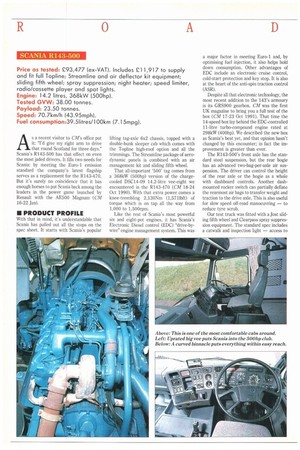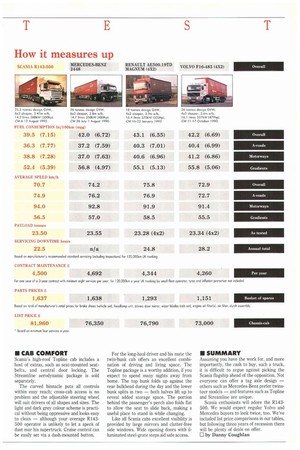Price as tested: £93,477 (ex-VAT). Includes £11,917 to supply arid
Page 32

Page 34

Page 35

If you've noticed an error in this article please click here to report it so we can fix it.
fit full Topline; Streamline and air deflector kit equipment; sliding fifth wheel; spray suppression; night heater; speed limiter, radio/cassette player and spot lights.
Engine: 14.2 litres, 368kW (500hp), Tested GVW: 38.00 tonnes.
Payload: 23.50 tonnes.
Speed: 70.7km/h (43.95mph).
Fuel consumption:39.51itres/100km (7.15mpg).
As a recent visitor to CM's office put it: "I'd give my right arm to drive that round Scotland for three days." Scania's R143-500 has that effect on even the most jaded drivers. It fills two needs for Scania: by meeting the Euro-1 emission standard the company's latest flagship serves as a replacement for the R143-470. But it's surely no coincidence that it has enough horses to put Scania back among the leaders in the power game launched by Renault with the AE500 Magnum (CM 16-22 Jan).
• PRODUCT PROFILE
With that in mind, it's understandable that Scania has pulled out all the stops on the spec sheet. It starts with Scania's popular lifting tag-axle 6x2 chassis, topped with a double-bunk sleeper cab which comes with the Topline high-roof option and all the trimmings. The Streamline package of aerodynamic panels is combined with an air management kit and sliding fifth wheel.
That all-important '500' tag comes from a 368kW (500hp) version of the chargecooled DSC14-09 14.2-litre vee-eight we encountered in the R143-470 (CM 18-24 Oct 1990). With that extra power comes a knee-trembling 2,130Nm (1,571lbft) of torque which is on tap all the way from 1,000 to 1,500rpm.
Like the rest of Scania's most powerful six and eight-pot engines, it has Scania's Electronic Diesel control (EDC) "drive-bywire" engine management system. This was a major factor in meeting Euro-1 and, by optimising fuel injection, it also helps hold down consumption. Other advantages of EDC include an electronic cruise control, cold-start protection and key stop. It is also at the heart of the anti-spin traction control (ASR).
Despite all that electronic technology, the most recent addition to the 143's armoury is its GRS900 gearbox. CM was the first UK magazine to bring you a full test of the box (CM 17-23 Oct 1991). That time the 14-speed box lay behind the EDC-controlled 11-litre turbo-compound engine rated at 298kW (400hp). We described the new box as Scania's best yet, and that opinion hasn't changed by this encounter; in fact the improvement is greater than ever.
The R143-500's front axle has the standard steel suspension, but the rear bogie has an advanced two-bag-per-axle air suspension. The driver can control the height of the rear axle or the bogie as a whole with dashboard controls. Another dashmounted rocker switch can partially deflate the rearmost air bags to transfer weight and traction to the drive axle. This is also useful for slow speed off-road manoeuvring — to reduce tyre scrub.
Our test truck was fitted with a Jost sliding fifth wheel and Clearpass spray suppression equipment. The standard spec includes a catwalk and inspection light — access to the catwalk is from the nearside, where a built-in step and handrail make for a safe climb. The cab's side air deflectors are hinged for access.
This was one of the last trucks to be registered before the October 1991 deadline for mandatory ABS equipment, so it still had the separate trailer brake control. This is incompatible with ABS so sadly Scania has been forced to drop it.
• PRODUCTIVITY
In a truck of this size and power productivity has more to do with journey times than fuel economy, but high powered trucks are not inevitably thirstier than their less well endowed brothers.
Every truck has its place, and the ideal place for an R143-500 is on long haul international transport involving more than a few big hills. The combination of roadspeed limiter, cruise control and effortless power allows a high average speed without speeding, while retaining acceptable fuel consumption. Don't buy this truck if you're running on the flatlands of Holland or even up and down the UK motorway network. You will get the fuel economy, but you'll never see what you paid for That said, the big Scania's overall fuel economy of 39.51k/100km (7_15mpg) beats the three most recent trucks we have tested in this class. Only Mercedes' 2448 twinsteer beat the Scania's economy_ But then only on motorway running and at an appreciably slower speed. The Scania's overall journey time was slightly slower than the others, but at over 70km/h for all types of
roads, ranging from city to fast motorway, it was still very quick. Kerb weight was 8.5 tonnes including 400 litres of fuel, but no spare wheel or carrier. Coupled to CMs tandem axle Crane Fruehauf test trailer with its six-tonnes nominal tare weight, this gives a 23.5-tonne payload which compares well with the other trucks in our sample.
• ON THE ROAD
This is the sort of truck drivers fight over. Power balanced by effective engine braking, good service brakes and competent steering make for a comfortable and relaxed drive, particularly when combined with the lighter, smoother gearchange.
Four-point cab air suspension, air-sprung rear end and driver's suspension seat provide for a very smooth ride, even when running solo. The rear axle can be raised when running light, which helps maintain traction for the drive tyres.
There's a nice touch when parking up: the handbrake works on the two rear axles, and applying it lowers the raised tag axle automatically. Start the engine the next morning and the axle will lift again.
As one of the last tag-axle tractors without an ABS system this truck demonstrated the classic limitation of tag-axle units under hard braking — two thick black skidmarks of increasing length appeared along with giant puffs of blue smoke as each test was run.
The tag axle wheels lock as the truck pitches forward with weight transfer: the axle goes light, it loses grip and the skid begins. ABS should prevent the lock up and, in theory, will further reduce the Scania's already acceptable braking distances. In any case, it only happened during emergency braking tests.
Most of the gradients on our test route were dealt with using the effective exhaust brake backed by the service brakes, with occasional tugs on the trailer brake.
• CAB COMFORT
Scania's high-roof Topline cab includes a host of extras, such as seat-mounted seatbelts, and central door locking. The Streamline aerodynamic package is sold separately.
The curved binnacle puts all controls within easy reach; cross-cab access is no problem and the adjustable steering wheel will suit drivers of all shapes and sizes. The light and dark grey colour scheme is practical without being oppressive and looks easy to clean although your average R143500 operator is unlikely to let a speck of dust mar his supertruck. Cruise control can be easily set via a dash-mounted button.
For the long-haul driver and his mate the twin-bunk cab offers an excellent combination of driving and living space. The Topline package is a worthy addition, if you expect to spend many nights away from home. The top bunk folds up against the rear bulkhead during the day and the lower bunk splits in two both halves lift up to reveal added storage space. The portion behind the passenger's perch also folds flat to allow the seat to slide back, making a useful place to stand in while changing.
Like all Scania cabs excellent visibility is provided by large mirrors and clutter-free side windows. Wide opening doors with illuminated steel-grate steps aid safe access.
• SUMMARY
Assuming you have the work for, and more importantly, the cash to buy, such a truck, it is difficult to argue against picking the Scania flagship ahead of the opposition. Not everyone can offer a tag axle design others such as Mercedes-Benz prefer twinsteer models and features such as Topline and Streamline are unique.
Scania enthusiasts will adore the R143500. We would expect regular Volvo and Mercedes buyers to look twice, too. We've included list price comparisons in our tables, but following three years of recession there will be plenty of deals on offer.
by Danny Coughian
















































































